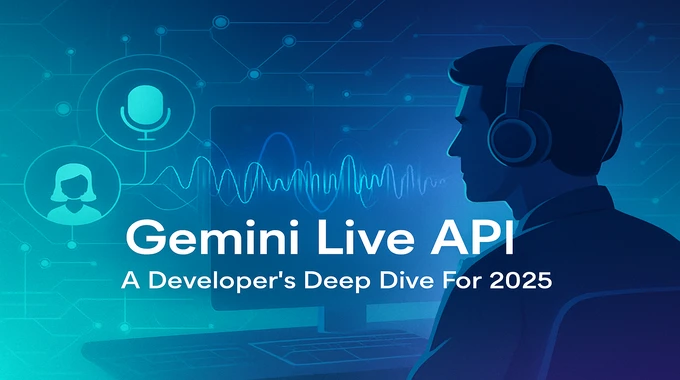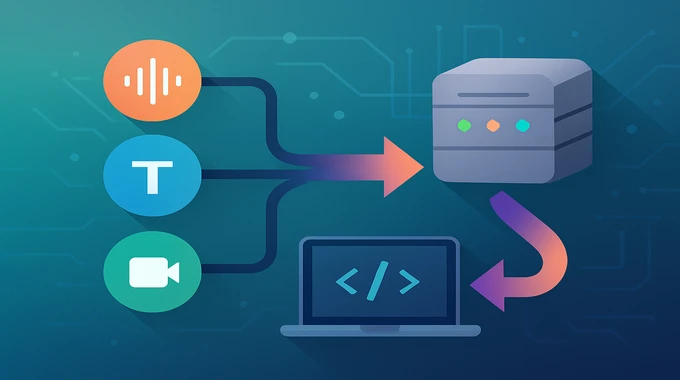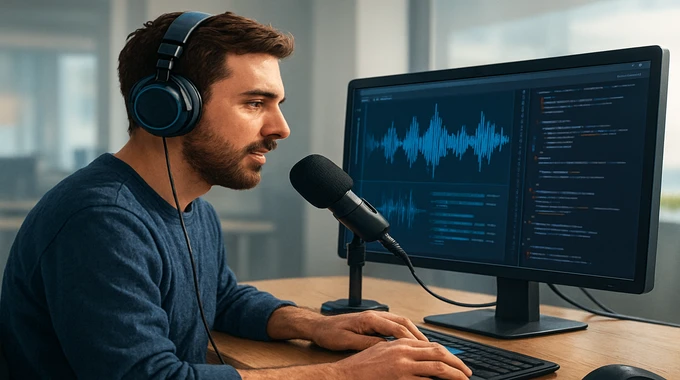You have been seeing the glossy demos. A voice that feels mesmerizingly present. A camera that understands what you are looking at. An assistant that speaks while you speak, then switches gear without losing the thread. The question that matters for builders is simple. How do you ship that experience without turning your stack into spaghetti. The answer is the Gemini Live API. It is not another prompt endpoint. It is a streaming engine for low-latency voice, video, and text that turns turn-based chat into real conversations.
If you are coming from the classic request-response model, this feels like moving from email to a phone call. You keep a persistent connection, stream inputs as they happen, and get incremental outputs in return. It changes how you design your app, your latency budget, and your pricing plan. In this guide, we will answer what is Gemini Live API, how to choose the right model, how to connect from client or server, how Gemini Live API pricing works, and how to stand up a working prototype. The goal is to hand you a map, then push you to build something real.
Table of Contents
1. Quick Decision Map

Use this table to lock key choices before you write a line of code.
| Decision | Options | Best For | Trade Offs | Notes |
|---|---|---|---|---|
| Audio Generation | Native Audio Models | Most natural speech, multilingual quality, affective dialogue, thinking mode | Preview tier. Tighter ops envelope at scale | Models like gemini-2.5-flash-preview-native-audio-dialog |
| Audio Generation | Half-Cascade Models | Production reliability, tool-use heavy flows | Slightly less natural than native audio | Models like gemini-live-2.5-flash-preview |
| Connection Path | Client to Server, direct WebSocket to the Gemini Live API | Lowest latency, simpler path for streaming | Requires secure auth on the client | Use short-lived ephemeral tokens, not long-lived API keys |
| Connection Path | Server to Server, your backend proxies the stream | Centralized control, observability, rate limits, billing | Extra hop adds latency | Useful when you must gate tools, data or policy checks |
| Core Capabilities | VAD, function calling, session state | Real conversations, tool-augmented answers | More moving parts | Plan for retries and backpressure |
| Cost Planning | Text vs Audio vs Video, Input vs Output | Accurate forecasting | Price varies by modality and direction | See Gemini Live API pricing section |
2. What Is Gemini Live API
The Gemini Live API keeps a persistent, bidirectional connection over WebSockets. You stream audio, video, or text from the user. The model streams back partial tokens or audio chunks as they are ready. The loop continues with natural interruptions, barge-in, and context carryover.
This unlocks products that felt clunky with single prompts. Think voice companions that do not pause awkwardly, on-device coaches that watch your screen share and talk you through a workflow, and translators that behave like a real interpreter, not a turn queue. The stack ships with voice activity detection, tool use, function calling, and session management so you can keep long conversations coherent. When people ask what is Gemini Live API, the short answer is, a real-time conversation pipe with brains.
2.1 Why Streaming Matters
Latency breaks the illusion of presence. The Gemini Live API minimizes round trips by maintaining a live session. You send frames or audio slices. You receive partial responses as soon as the model is confident. You do not wait for the entire result to render. Users feel heard because the system behaves like another person on the line.
2.2 A Note On Models
Choose the audio generation path early. Native audio models produce stunning speech quality with richer prosody and emotion. Half-cascade models are the production workhorse for tool-heavy flows, since text is an internal step that plays nicely with function calls and logs.
3. Choose Your Audio Generation Architecture
Your first fork in the road is the audio stack.
3.1 Native Audio Models, Maximum Naturalness
Native audio models generate speech directly from the model’s internal state. The result sounds less robotic and more expressive. You also gain affective dialogue, where the system mirrors user tone, and a thinking mode for more considered replies. This is my pick when your product lives or dies by voice quality, like coaching, narration, or assistive tech that speaks most of the time.
Trade offs exist. These models are often in preview. They evolve fast. Plan for version pinning, guard rails, and canary traffic before you roll out at scale.
3.2 Half-Cascade Models, Production Friendly
Half-cascade models take audio in, decide what to say as text inside the model, then pass that text to a top-tier TTS layer. You get reliability, logging, and stronger tool use. If your assistant is calling functions, hitting databases, or orchestrating APIs mid-conversation, this path keeps complexity in check. Voice quality is excellent, just a notch below native audio in warmth.
4. Choose Your Implementation Path

Your second fork is where to terminate the WebSocket.
4.1 Client To Server, Direct To Google
Frontends connect straight to the Gemini Live API. This is the latency winner. One hop. No proxy for the stream. The challenge is security. You never ship a static API key. You mint ephemeral tokens on your backend, short-lived and single-use, then the client uses that token to open the session. Rotate, expire, log, and you are safe.
4.2 Server To Server
Your client streams to your server. Your server opens the Live session and forwards packets. You gain full control, centralized logging, request shaping, and policy enforcement. The extra hop costs milliseconds. For some products, that cost is acceptable in exchange for observability and fine-grained governance.
5. Gemini Live API Pricing
Gemini Live API pricing depends on modality and direction. Text is cheapest. Audio and video cost more because they move more data and must respond fast. You pay separately for input and output.
Pricing Table, Paid Tier
| Model | Modality | Direction | Price (USD per 1M tokens) |
|---|---|---|---|
| Gemini 2.5 Flash, Live API | Text | Input | $0.50 |
| Text | Output | $2.00 | |
| Audio, Image, Video | Input | $3.00 | |
| Audio | Output | $12.00 | |
| Gemini 2.0 Flash, Live API | Text | Input | $0.35 |
| Text | Output | $1.50 | |
| Audio, Image, Video | Input | $2.10 | |
| Audio | Output | $8.50 |
Rates above are from Google’s official pricing and were last updated on August 21, 2025. Always confirm current numbers before launch.
Model Your Cost In Four Steps
- Estimate minutes of audio input per session.
- Estimate minutes of audio output per session.
- Convert those minutes to Google’s billing units, then apply the input and output rates for your chosen model.
- Run a quick sensitivity analysis for short sessions, typical sessions, and chatty users so finance and product can plan with confidence.
5.1 A Worked Example
Assume a five-minute voice session using a flash family model.
- Audio input, user speaks for five minutes total. Treat that as 300 seconds of streamed input.
- Audio output, the assistant speaks for two and a half minutes total.
- Apply current audio input and audio output rates for your chosen model tier.
- You will land in the low single-digit dollars per session for a rich, real-time interaction.
Now run the same math for text-first flows. If your assistant mainly returns text with occasional audio, your costs drop a lot. This is why you should design for silent confirmations where voice adds little. Good UX lowers cost.
6. A Gemini Live API Tutorial

Time to wire up a minimal, end-to-end loop. This Gemini Live API tutorial uses the Python client to stream a short WAV and save the spoken reply. You can adapt the same shape to JavaScript.
6.1 Setup
- Create an API key in AI Studio. Store it in your secret manager.
- Install the client and audio helpers:
pip install -U google-generativeai librosa soundfile
- Place a 16 kHz mono WAV in your project folder as sample.wav.
6.2 Stream In, Stream Out
- Open a live session with your chosen model.
- Convert your source audio to 16-bit PCM at 16 kHz if needed.
- Send audio slices through the session as realtime input.
- Set the response modality to audio. The service streams back 24 kHz audio chunks.
- Write chunks to a file or feed them to your playback pipeline.
That is the whole loop. Replace the file with microphone frames. Replace the file writer with your speaker output. You now have a skeleton voice assistant talking to the Gemini Live API.
6.2.1 Minimal Code, Python
# Minimal "stream in, stream out" example for Gemini Live API
# Requires: pip install google-generativeai librosa soundfile
# Saves the model's spoken reply to out.wav
import os
import io
import asyncio
import wave
import librosa
import soundfile as sf
from google import genai
from google.genai import types
# 1) Auth, prefer environment variables in production
# export GEMINI_API_KEY="your_key"
genai.configure(api_key=os.environ["GEMINI_API_KEY"])
# 2) Pick a Live-capable model
# Half-cascade, production friendly:
MODEL_NAME = "gemini-live-2.5-flash-preview"
# Or native audio, most natural voice quality:
# MODEL_NAME = "gemini-2.5-flash-preview-native-audio-dialog"
# 3) Session config, ask for audio back
CONFIG = {
"response_modalities": ["AUDIO"],
"system_instruction": "You are a helpful assistant. Keep replies concise.",
}
# 4) Convert source audio to 16 kHz, 16-bit PCM, mono, then stream it in
def load_pcm16_16khz(path: str) -> bytes:
buf = io.BytesIO()
y, sr = librosa.load(path, sr=16000, mono=True)
sf.write(buf, y, 16000, format="RAW", subtype="PCM_16")
buf.seek(0)
return buf.read()
async def main():
# Prepare a short input sample
audio_bytes = load_pcm16_16khz("sample.wav") # put a short WAV in your project root
# Open a persistent Live session
async with genai.Client().aio.live.connect(model=MODEL_NAME, config=CONFIG) as session:
# Stream audio input to the model
await session.send_realtime_input(
audio=types.Blob(data=audio_bytes, mime_type="audio/pcm;rate=16000")
)
# Prepare an output WAV at 24 kHz, 16-bit PCM, mono
with wave.open("out.wav", "wb") as wf:
wf.setnchannels(1)
wf.setsampwidth(2)
wf.setframerate(24000)
# Receive audio chunks from the model and write them out as they arrive
async for evt in session.receive():
if getattr(evt, "data", None):
wf.writeframes(evt.data)
print("Saved model audio to out.wav")
if __name__ == "__main__":
asyncio.run(main())
6.3 Direct Web App Variant
If you need the absolute lowest latency for a web client, connect from the browser to the Gemini Live API with WebSockets. Your backend issues ephemeral tokens on demand. The browser streams microphone frames in. The model streams audio chunks back. Keep your token TTL tight, then refresh automatically inside the session. This pattern is fast, safe, and simple to reason about.
7. Make It Useful, Tools, Functions, And Memory
Real assistants do work. The Gemini Live API supports tool use and function calling so the model can call your code during a conversation.
- Define tool schemas that describe what your functions do and what parameters they require.
- Provide tool results quickly, ideally within your latency budget for a single turn.
- Store facts from the session in lightweight memory keyed by user and purpose. Keep it scoped, auditable, and easy to erase.
This turns a demo into a product. Ask the assistant for a customer’s order status. It calls your function, fetches the record, then answers in a sentence instead of hallucinating.
8. Session Management That Works
Long conversations drift without state. Use the session APIs to carry context, system instructions, and goals across turns. Summarize periodically, not at every turn, to save cost and time. Pin safety instructions and style guides in your system messages. If your assistant switches tasks, checkpoint the session, then resume with a clean objective.
9. Latency, The Quiet Product Manager
You feel latency in your jaw. Anything over 200 to 300 ms between stop-speaking and start-hearing breaks the rhythm of speech. Profile like a gamer.
- Capture microphone frames in small buffers.
- Send as you capture, not after you accumulate.
- Use a direct connection when voice quality is the product.
- Render partial results. Start TTS playback as soon as the first chunk lands.
- Keep your tool functions tight. Slow tools cause slow voices.
Every millisecond you save improves the illusion of presence. That is the core promise of the Google Gemini Live API stack.
10. The Difference Between Demo And Deployment
You cannot fix what you cannot see. Add structured logs at the session boundary.
- Log session start and end, model name, and token counts by modality.
- Track per-turn timing, input duration, output duration, and tool call latencies.
- Sample audio levels, not full audio, for privacy. Watch for clipping and silence.
- Build a trace for escalations to human agents. Keep the transcript when users consent.
This data helps you answer the questions you will get on day two. Why was this turn slow. Which function failed. How much did this customer cost.
11. Shipping Without Leaks
Never ship a long-lived key to the browser. Use short-lived ephemeral tokens that bind to a user, a model, and a time window. Scope your tools. Deny by default, then allow per capability. Rate limit per user and per IP. Encrypt recordings at rest. Make deletion requests a first-class feature, then test them.
12. Roadmap Watchlist
Keep an eye on model upgrades to native audio quality, broader language coverage, and tighter tool integration. Watch for better mobile runtime primitives that reduce capture and playback latency. Track the Google Gemini Live API docs for token policies and new response controls. The platform is moving quickly. Your advantage is a clean architecture that lets you adopt improvements without refactoring your app.
13. Build The Conversation You Want To Use
The Gemini Live API turns AI from a form into a presence. Pick your audio stack with intention. Choose the connection path that matches your latency and control needs. Model cost with clear scenarios. Ship a small Gemini Live API tutorial app, then wire in tools, memory, and guard rails. When you are ready, put it in front of users who will not spare your feelings.
You are not writing prompts anymore. You are designing a conversation. Open your first session, say hello, and listen for the moment when the reply feels natural. That is your north star.
Call to action. Build a minimal voice loop today. Swap in native audio tomorrow. Add one tool the day after. Publish your learnings. Then come back and push the boundary again, this time with the Gemini Live API leading the way.
What is the Gemini Live API?
The Gemini Live API is Google’s real‑time streaming interface that allows developers to send continuous audio, video, or text to a Gemini model over WebSockets. Unlike traditional request–response endpoints, it maintains a bidirectional connection so users can speak or stream data while the model returns partial responses. This low‑latency design enables fluid conversations and natural interruption handling.
How does Gemini Live API pricing work?
Pricing depends on the model tier and the modality of input and output. Google charges separately for input and output tokens. Text is the most affordable, while audio and video are more expensive due to higher data volumes and stricter latency guarantees. Different models, such as 2.0 Flash and 2.5 Flash, have distinct rates. Always check the latest pricing documentation before budgeting.
Can I connect directly from a web client?
Yes. Web clients can open a WebSocket directly to the Gemini Live API, which offers the lowest latency. In this setup your backend issues short‑lived, single‑use tokens to the browser and never exposes an API key. The browser streams microphone or camera frames in and receives partial responses in return. This pattern suits interactive voice or video experiences where every millisecond counts.
What models are available for Gemini Live API?
Gemini currently offers “Native Audio” models that generate speech directly from internal state, producing expressive and human‑like voices, and “Half‑Cascade” models that first convert audio to text internally. Native models deliver richer prosody but may be in preview. Half‑Cascade models are generally more stable and integrate well with tool‑calling scenarios. Choosing between them depends on your priorities.
How do I prototype with the Gemini Live API?
A simple prototype involves creating an API key, installing Google’s client SDK, and opening a WebSocket session to your chosen model. Stream a mono 16 kHz WAV as input and set the response modality to audio to receive 24 kHz chunks. You can adapt this pattern for JavaScript or other languages. For lower latency in web apps, connect directly from the browser with issued tokens.
